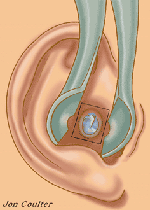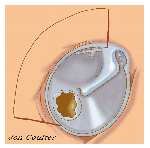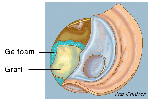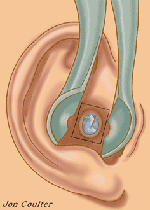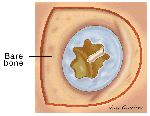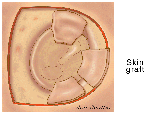Perforated Ear Drum
A perforated ear drum is a hole in the ear drum.Treatment for Perforated Ear Drum
Treatment of a perforated ear drum depends on several factors. In some non-symptomatic patients, a very small perforation can sometimes be left alone to heal on its own. In fact, sometimes even if a very small perforation does not heal on its own, it can still be left alone if the patient is asymptomatic. Additionally, some patients are able to have a 'paper patch' placed over the perforation in the office; the patch allows an avenue through which skin can grow to reach the other side of the perforation, thus closing the hole. However, a large majority of patients need surgical repair of an ear drum perforation. This procedure is called a tympanoplasty and involves general anesthesia. In this procedure, fascia (fibrous tissue) is taken from the patient’s own ear and placed as a graft over the perforation.
Step 1: The underlay technique is illustrated. The eardrum and ear canal are magnified.
An alternative is to place the graft over the perforation, a technique called a lateral graft technique.
Step 2: An incision is made in the ear canal. The edges of the hole in the eardrum are removed.
Step 3: The ear canal skin and portion of the eardrum are lifted. A temporalis fascia graft is placed under the hole in the eardrum. The graft is supported by absorbable gelfoam packing.
Step 4: The eardrum and ear canal skin is laid back.
Step 1: The lateral graft technique is illustrated. The eardrum and ear canal are magnified.
Step 2: A circumferential incision is made in the ear canal.
Step 3: The skin of the ear canal is elevated down to the eardrum and is removed along with the skin layer of the eardrum.
Step 4: A temporalis fascia graft is then placed over the eardrum, effectively closing the hole.
Step 5: Pieces of the ear canal skin are then placed over the bare ear canal and temporalis fascia graft.


